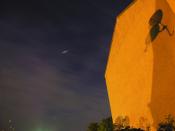Various theories have been put forward for the mass-extinction about 65 million years ago at the end of the cretaceous period that caused the extinction of the dinosaurs: These range from disease to tropical cyclones and even alien abductions have been suggested. However the most popular theory is that a giant meteor struck the Earth. This came about from guesswork and from a high level of the rare amount Iridium found at the boundary between Cretaceous and Tertiary rocks 65 million years old: this is likely to be caused by either of two things: from cosmic matter, i.e. a meteorite, or from the mantle inside the Earth, i.e. from volcanoes. The most popular theory remains the Meteor theory. The main implication here is not the impact of the meteor (it is hypothesised that a crater which is in Northern Arizona is the crater of this meteor and it is also thought that an explosion from the Tunguska River in Syberia could be responsible, although it looks doubtful in my opinion.
It is also hypothesised that the crater is now on the sea bed, which is certainly possible) but the clouds of dust which it threw up into the atmosphere. This dust caused an extremely sudden change in the climate of the atmosphere: this made it difficult to breathe to a certain extent but the main problem associated was that the dust obscured the sun blocking sunlight from reaching the Earth causing darkness and a drop in temperature. In the sea the lack of light caused chaos for the photosynthesising nannoplankton algae. Collapse of the ocean's algae communities meant troubles for the zooplankton which fed of them and therefore all the other animals that fed on them. There was also a decrease in Oxygen levels and strong up-currents. This led to...


